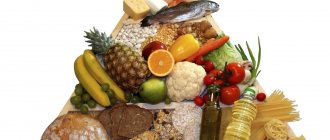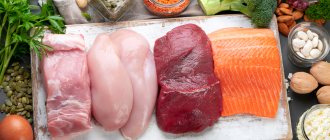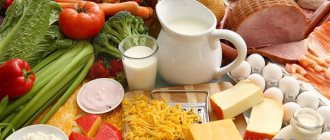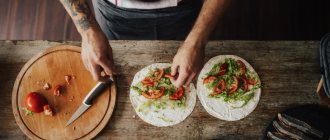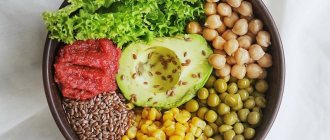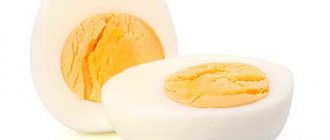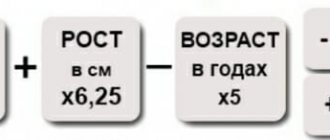A trio of proteins, fats and carbohydrates is the basis of a daily diet that helps the body function smoothly, maintain health and fill it with energy.
I’ll tell you why we need BJUs in combination with each other, how to correctly calculate their number and why all this is needed in general - briefly and to the point. At the end of the article you will find a table with proportions that will make taking care of your health even simpler and more enjoyable.
A deficiency or excess of these substances is reflected negatively. Therefore, the amount of BJU must be consumed in certain proportions depending on gender, weight and other parameters.
Proteins, fats and carbohydrates - what is their function?
Nutrients perform vital work for the body, supplying useful elements in sufficient quantities. If we only drank water and took vitamins and microelements from dietary supplements, our internal systems would stop developing.
The listed substances have practically no independent calories, despite the fact that together they complement the nutritional value of the products.
Without BJU and fiber, our body experiences an acute nutritional deficiency. Accordingly, this slows down all internal processes and stops the formation of muscle and other tissues.
For this reason, nutritionists do not recommend long-term fasting. For example, eat only fruits or “sit” on kefir for a month. Like all living things, the body needs balance.
Squirrels
The main element for building muscles and supporting the immune system. If the body experiences a deficiency of fats and carbohydrates, proteins take on the energy function. Why is this bad: protein synthesis is disrupted, and everyone feels the failure - the immune system weakens, swelling appears, and muscles disappear.
Excess is also not a gift, since the risk of protein poisoning, kidney failure and increased calcium output increases (excessive protein diet during pregnancy is a risk of pathologies in the child).
What food to get proteins from:
- eggs (chicken, goose, etc.);
- meat (not to be confused with semi-finished meat products in the form of sausages);
- cheese, milk and other fermented milk products;
- Fish and seafood;
- lentils, chickpeas and other legumes.
It is important to combine the source of proteins, not limiting yourself to turkey meat or pollock. It is optimal to combine plant and animal proteins to obtain various excipients.
What are the benefits of proteins:
- maintain muscle tone and promote their growth;
- improve the condition of blood vessels;
- in childhood they are responsible for growth function;
- strengthen immune defense;
- makes hair and nails strong.
The optimal daily proportion of plant and animal proteins is 55:45 (this is approximately 100 g of protein food daily).
What threatens the lack of proteins: If a long-term deficiency occurs, the system turns to the muscles and cells, “pulling” the necessary substances from them, which leads to functional disruptions in the functioning of the thyroid gland, gonads, and adrenal glands.
Unlike fats and carbohydrates, proteins cannot accumulate in the body, so “supplies” must be made regularly.
Fats
An important supplier of energy (1 g of fat accounts for 9 kcal).
They consist of fatty acids, each of which performs its own task. These include substances of natural origin, excluding substitutes and solid fats from baked goods, sausages, fast foods, etc. The permissible limit for such substances is no more than 20 g per day.
What are the dangers of a lack of fat? The lack of this nutritional element affects the beauty of the skin (dry and very dry), provokes swelling and hormonal imbalance, and leads to problems with the kidneys and liver.
The fats the body needs are contained in:
- in sunflower, olive, corn and other vegetable oils (not counting industrial palm oil, with which production is overflowing);
- in butter, fish, meat and other animal products.
What are the benefits of fats:
- keep the walls of blood vessels elastic;
- form a reserve energy reserve;
- help support immune defense.
With the help of fats, the body is able to absorb fat-soluble vitamins - A, D and E (therefore, “canned” vitamins must be taken together with fish oil, otherwise they will pass by).
Therefore, it is worth adhering to the daily intake of fats of plant and animal origin in a ratio of 40:60 (this is approximately 30 to 70 g per day).
There is also nothing good in excess fat - it threatens with serious consequences. For example, excess weight with concomitant diseases or high cholesterol, which leads to the development of atherosclerosis.
Carbohydrates
They are divided into two groups - simple and complex. The first are glucose, fructose, maltose, sucrose and other derivatives. Contained in fruits, potatoes, white rice, candy, soda, baked goods, cookies, etc.
Carbohydrates from buns and sweets do not stay in the body - they quickly disintegrate, due to which the blood sugar level instantly increases, satisfying hunger for a short period of time (the story is called: “kill appetite”).
Complex carbohydrates - they are also healthy - contain fiber, so they take longer to digest in the stomach, effectively satiating you. Gradually breaking down into simple carbohydrates, they do not cause a sharp jump in sugar - the feeling of hunger goes away a little more slowly, but does not return soon.
Plus, the body receives a portion of fiber, which maintains a feeling of fullness in the stomach, and at the same time improves intestinal motility.
Sources of complex carbohydrates:
- whole grain cereals;
- fresh vegetables;
- legumes;
- whole grain bread, etc.
Carbohydrate foods provide the body with energy, and together with protein foods, they help maintain construction function and participate in the formation of cartilage tissue and hormonal balance.
What are the consequences of a lack of carbohydrates? The consumption of complex carbohydrates is indispensable for the quality of the heart and blood vessels. Recent studies have shown that low- or no-carbohydrate diets carry a risk of degenerative changes in the myocardium and aggravate the condition of the capillaries.
Therefore, a small amount of carbohydrate food is necessary even on a diet. The main thing is to make the right choice, and instead of chocolates, treat yourself to sweet fruits, and replace white bread with grain bread.
However, an excessive amount of either simple or complex carbohydrates is sent to fat reserves, forming a “veil” over problem areas. Accordingly, the amount of cholesterol increases, with all that it implies.
The optimal daily proportion of complex/simple carbohydrates is 75:25 (approximately 50% of the total calorie intake).
The conclusion is obvious - the body needs balance, because it is a reliable protection against failures, the development of various diseases and other negative factors, the cause of which is an unbalanced diet.
To ensure that nutrients work exclusively for your benefit, learn to make the correct calculation of KBZHU. It will be difficult at first, but soon you will be able to determine the normal ratio of protein, carbohydrates and fat in the product “by eye”.
How to create a separate meals menu for the week?
The menu should change depending on the season of the year, the characteristics of your climate and the location of your country.
Study the principles and rules of separate meals and adjust, develop and compose your menu.
Any green vegetable, starch or protein can be replaced with another product from the corresponding group.
For example, replace pumpkin with potatoes; spinach - beet tops. Creating a menu will not be difficult for you. Add variety to your food every day, do not make it monotonous.
Adviсe:
- Starches should be taken in the daytime with a small amount of vegetable salad. Eat starches dry, chew well, coat generously with saliva. Do not add acids to the salad. It is advisable not to mix starch with white and cauliflower cabbage, legumes, garlic, and onions.
- Take protein foods with plenty of salad, two boiled green vegetables, in the evening. Proteins are any meat, fish, eggs, nuts, olives, avocado, cheese.
- It is advisable not to eat fruits between meals; it is better to replace one meal with fruits or eat them half an hour before meals. They are little processed in the mouth or stomach, being digested mainly in the intestines. It is best to eat them for breakfast, without overloading the body, which has not woken up from sleep, giving the opportunity to fully absorb all the vitamins from the fruit.
List of fruits:
- Sweet fruits: Banana.
- Dried fruits (dried dates, figs, pears, prunes, raisins).
- Persimmon.
- Muscat black grapes.
- Sweet apples, plums, grapes (raisins).
- Citruses.
Calculation of KBJU - make your diet balanced and healthy
Nutrients in the correct proportion are exactly what every human body needs. Nutritionists agree that for balance it is necessary to create a menu in the following percentage: 30% fats and proteins, 40% carbohydrates.
Regarding the latter, it is advisable to give preference to complex brothers, and behave carefully with simple ones. Glucose is important for “recharging” mental activity, but it is better to approach it wisely, if possible replacing sweets with fresh fruits and berries (without fanaticism - they also contain a lot of sugars).
There are nuances in calculating proportions, since it is important to consider:
- age and gender;
- health status;
- metabolic rate;
- pregnancy/lactation period;
- lifestyle (athlete, office worker, couch potato).
If you are overweight or obese, it is optimal to reduce the amount of foods rich in fat, leaving the key ones - polyunsaturated fats (found in fish, sunflower oil, pine nuts, eggs). And now - to the calculation.
Squirrels
Together with food, we should receive at least 0.8 grams of the substance per 1 kg of weight.
Optimal: 1.3-1.4 g/kg for women and 1.4-1.5 g/kg for men. For those who lead an active lifestyle, play sports or experience high physical activity, the norm increases: 1.5 g/kg for women, 1.6-1.8 g/kg for men.
Within the normal range, the protein diet should not exceed 2 g/kg, however, without negative consequences, a person can absorb from 2 to 2.5 g/kg (in relation to the goal - this is important with high aerobic activity and intense training).
Fats
For a person with a medium to thin build who does not experience physical activity, the norm of the substance is 1-2 g/kg body weight.
The amount in grams is similar for obese people, with one “but”: 1-2 g per 1 kg of dry weight, that is, without taking into account accumulated fat (you can find out the percentage of body composition from a nutritionist).
Carbohydrates
The proportion of the substance depends on the purpose. So, for weight loss the norm will be 1.5-2 g/kg. To maintain weight, 2-3 g/kg is enough. If you need to gain weight, the norm increases to 5-6 g/kg.
If a person is engaged in hard work or leads an active lifestyle, the recommended norm is 6-9 g/kg. With average physical activity from 4 to 5 g/kg. Going beyond the limits can have a negative impact on health, including in the long term.
Calculation of KBZHU in numbers
Let's look at the calculation using the example of a 30-year-old woman weighing 63 kg, who is breastfeeding a 6-month-old baby and does not want to gain a single extra kilogram. She eats 2,225 kcal daily.
In such a situation, 1.4 g/kg of protein food and 1 g/kg of fatty food is sufficient for a balanced diet.
Let’s do the calculation (it’s convenient to calculate the volume of “carbohydrate” calories using the formula: amount of protein x 4 and amount of fat x 9):
1.4 x 4 x 63 + 1 x 9 x 63 = 919.8 kcal (respectively, 352.8 kcal from protein and 567 kcal from fat).
Now we subtract proteins from carbohydrates from the total calorie content and get 1,305 carbohydrate calories.
Separate meals menu for 7 days
Sample menu for the week in the table:
| Day | Menu |
| 1 | Breakfast: citruses, pineapples. Dinner: vegetable salad, cauliflower, potatoes. Dinner: avocado, lettuce, young zucchini. |
| 2 | Breakfast: apples or pears (or both). Dinner: vegetable salad, beets, carrots, stewed lentils. Dinner: fish, green vegetable salad, leek, spinach. |
| 3 | Breakfast: apricot, peach, cherry. Dinner: broccoli, chard, vegetable salad, artichokes. Dinner: boiled turkey, red cabbage, green beans, tops salad. |
| 4 | Breakfast: melon. Dinner: cauliflower, cucumbers, vegetable salad, buckwheat. Dinner: nuts, broccoli sunflower seeds, tops salad. |
| 5 | Breakfast: berries with cream (no sugar). Dinner: green vegetable salad, herbs, carrots, chestnuts. Dinner: cottage cheese, light vegetable salad, radishes, cucumbers. |
| 6 | Breakfast: watermelon. Dinner: green vegetable salad, stewed eggplant, whole grain bread. Dinner: eggs, young pumpkin, turnip, vegetable salad. |
| 7 | Breakfast: dry fruits: raisins, dried pear, prunes and a glass of curdled milk. Dinner: green vegetable salad, green beans, Chinese cabbage, buckwheat. Dinner: hard cheese, lettuce, tomato. |
How to calculate the ideal BZHU ratio for weight loss
Several years ago, the ratio of proteins, fats and carbohydrates was used according to the scheme 1: 1: 4 (in percentage - 16.6, 16.6, 66.8). Later it turned out that this was a mistake.
The misconception has been dispelled by recent studies, which have convincingly proven that eating according to a diet with such a significant gap in nutrients leads to an imbalance of nutrients.
Receiving a lot of carbohydrates, the body experiences a slight deficiency of other nutrients, which reduces the absorption of nutrients (most of it settles for future use - on the sides, stomach and other problem areas).
The percentage of the norm was adjusted: 18, 15 and 67.
But here, too, not everything is as simple as it seems, since there is no universal proportion. This depends on gender, age, body type and level of physical activity. Let's see in comparison.
BZHU for weight loss
To find out the calorie intake for weight loss, you need to adjust the standard regimen.
We determine the total calorie content of the daily diet (or calorie corridor), reducing the total volume by 15-20%. What happens at a rate of 1800 kcal per day:
- 40-50% - proteins;
- 30-40% - fats;
- 10-20% are carbohydrates.
At the same time, you should not significantly underestimate the limit - this may affect metabolism, which risks slowing down. If the goal is to maintain weight through active training and acquire beautiful relief, the daily norm figures are adjusted to plus 20-40%.
The ideal ratio of BZHU for weight loss:
- 25-35% - proteins;
- 10-15% - fats;
- 40-60% are carbohydrates.
The increase in carbohydrate food during high load covers the energy expenditure during training - there is no need to worry that excess is formed to be sent to fat.
Calorie table for drinks
All kinds of drinks are present on the menu of any person every day. And this is where many people make mistakes in counting calories, because they do not take into account the calorie content of, for example, cappuccino, but milk is added to it, which has a certain energy value. Adding sugar also significantly increases the calorie content of the drink.
Alcoholic drinks
If you drink alcohol in moderation, this will not have a significant effect on the overall level of muscle mass gain. But still, the tandem of alcohol and a balanced diet is not very successful. Alcohol blocks the process of breaking down protein into amino acids, which reduces the rate of fat burning and reduces the process of building muscle mass.
Alcohol also removes fluid from the body, which interferes with the process of protein absorption, neutralizing any goal pursued by a person.
| Products, 100 g | Proteins, g | Fats, g | Carbohydrates, g | Energy, kcal |
| Vermouth Cinzano, Martini | — | — | 14,5-18 | 138-155 |
| Dry grape wines, white and red, c. including sparkling | 0-0,2 | — | 0,1-0,4 | 56-95 |
| Semi-dry white and red grape wines, c. including sparkling | 0,3 | — | 2,5 | 78 |
| Semi-sweet white and red grape wines, c. including sparkling | 0,2 | — | 5 | 88 |
| Sweet grape wines, white and red, c. including sparkling | 0,2 | — | 8 | 100 |
| Strong grape wines | 0,4 | — | 12 | 163 |
| Grape liqueur wines | 0,5 | — | 30 | 212 |
| Whiskey | — | — | 0,4 | 235 |
| Vodka | — | — | 0,4 | 235 |
| Gin | — | — | — | 230 |
| Gin and tonic | — | — | 6,7 | 78 |
| Cahors | — | — | 16 | 147 |
| Cognac | — | — | 0,1 | 239 |
| Amaretto liqueur | — | — | 35 | 280 |
| Baileys liqueur | 3 | 13 | 25 | 327 |
| Cointreau liqueur | — | — | 20 | 197 |
| Kahlua liqueur | 0,6 | 0,7 | 41,7 | 291 |
| Liqueur "Malibu" | — | — | 20 | 197 |
| Light light beer | 0,3 | — | 4,6-5,5 | 42-46 |
| Dark light beer | 0,3 | — | 5,7 | 48 |
| Port wine | 0,4 | — | 12 | 163 |
| Rum | — | — | — | 220 |
| sake | 0,5 | — | 5 | 134 |
| Moonshine | 0,1 | 0,1 | 0,4 | 235 |
| Ethyl alcohol 96% | 4 | — | 3,8 | 710 |
| Tequila | 1,4 | 0,3 | 24 | 231 |
| Chacha | 0,1 | 0,1 | 0,5 | 225 |
The ideal ratio of KBJU - how to find it?
An appointment with a nutritionist is the only way to reliably learn everything about the peculiarities of your body’s functioning. The doctor will find out the speed of metabolic processes and the amount of “hidden” fat in order to determine the calorie intake for sure.
The only universal principle remains - do not create a deficiency, since each of the nutrients is important for the quality functioning of the body. For example, you shouldn’t completely give up pasta if you can replace a portion of “shells” with spaghetti made from durum wheat.
But it’s better to get rid of ketchup and other sauces from the store. They contain a lot of added sugars and additionally “warm up” the appetite, creating fertile ground for growth in breadth. Eat vegetables in any form (except fried).
Make sure that your plate always contains foods with polyunsaturated fatty acids (fish, etc.). Even in the process of losing weight, the body needs energy. A variety of foods in your diet is a proven defense against dieting breakdown.
Include all healthy nutrients in your menu every day:
- 80 g proteins;
- 50-60 g fat;
- 70-80 g carbohydrates.
What types of products are it desirable to obtain them from:
- 45% animal proteins - beef, lean pork, eggs, poultry;
- 55% plant proteins - nuts, legumes, soy;
- 70% animal fats - butter, cream, etc.;
- 30% vegetable fats - vegetable oil, avocado, various seeds.
Remember that BJUs are not produced by the body on its own. Our goal is to provide the required amount of nutrients every day. By deliberately reducing your diet to fruits and kefir, you can subsequently discover health problems.
Eat right, without reducing weight loss to a total hunger strike. The long-term effect of this approach is more illusory than real: today you have lost weight, and tomorrow your hand will reach for what you deprived yourself of in the process.
Replace candies and milk chocolate with natural sweets - strawberries, apricots, bananas, etc. When looking at unhealthy foods, look for healthy alternatives. They definitely exist - see for yourself.
Recipes for separate meals
Salad with cheese without mayonnaise
Ingredients for 4 servings:
- 200 grams each of cauliflower and green beans;
- 3 pieces of bell pepper and tomatoes;
- 1 piece of young zucchini;
- 100 grams of cheese;
- herbs, olive oil, lemon juice.
Preparation:
- Boil the cauliflower and green beans in salted water for about 10 minutes.
- Cut bell peppers and tomatoes into strips.
- Grate the zucchini and fry in olive oil.
- Tear the greens with your hands, add the diced cheese to the vegetables, pour in lemon juice, and stir. Salad ready!
Boiled rice with fried vegetables
Ingredients for 4 servings:
- 2 cups rice;
- one package of deep-frozen vegetables;
- onion;
- olive oil.
Preparation:
- Remove the bag of frozen vegetables from the freezer ahead of time.
- Rinse the rice, boil until tender, strain.
- Fry the onion until translucent in a small amount of olive oil.
- Add salt and a mixture of vegetables to the onion. Fry for 10 minutes.
- Add rice to the frying pan and fry until the rice is heated through.
- Serve sprinkled with herbs.
Baked apple
Ingredients for 4 servings:
- 4 apples;
- 85 g dried fruit mixture;
- 1 tsp. cinnamon.
Preparation:
- Rinse the apples.
- Cut out the core.
- Mix dried fruits with honey.
- Stuff apples with dried fruit mixture.
- Bake in the oven at 1900C for 40 minutes until the apples soften.
- Sprinkle baked apples with cinnamon.
- The dish is ready.
In this article, you learned all the principles and rules of separate nutrition, about the features of the process of digesting food groups, diets based on blood types, raw nutrition and weight loss. You have learned to combine foods for normal digestion.
Eat the best combination of foods, don't overeat, drink clean water every day and be active. Lead a healthy lifestyle, be optimistic and you won’t be afraid of any disease!
Reviews
Reviews from people about separate meals:
Alexandrova Anastasia
Nutrition and healthy lifestyle specialist and author of myfitnesblog.com. For many years, she has successfully helped women and men lose weight and maintain a beautiful figure.
